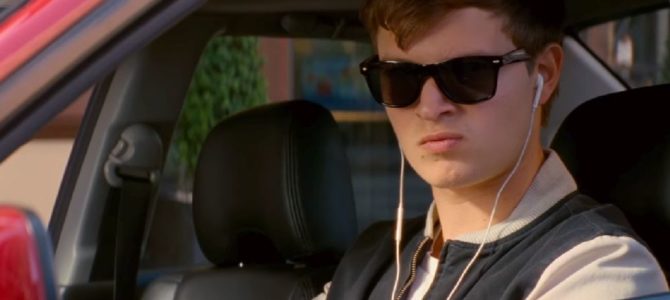
Every time I told someone I planned to see a movie called “Baby Driver,” the response was the same. Everyone told me, “That sounds terrible,” and I had to agree. It does sound terrible. It’s an awful name for a movie, but the movie itself is amazing.
Perhaps the incongruous naming was intentional, because “Baby Driver” is a heist movie that defies expectations. It’s the brainchild of Edgar Wright, who has created many cult classics, including “Shaun of the Dead” (2004) and “Hot Fuzz” (2007). Wright’s movies are often violent and laden with profanity, but they also tend to be whimsically quirky, featuring characters with heart. With “Baby Driver,” Wright infuses the heist genre with an originality that’s consistent with his previous work.
‘A Good Kid and a Devil Behind the Wheel’
“Baby Driver” is a movie about a young man named Baby who drives the get-away car for a gang of brazen bank robbers. Ansel Elgort, who’s known for roles in terrible young-adult-book adaptations, surprised me with his quiet yet compelling performance as Baby. Kevin Spacey plays Doc, doing the kind of thing that Spacey does so well—i.e., being an evil mastermind.
Doc describes Baby as “a good kid and a devil behind the wheel.” The rest of the crew aren’t such good kids. Spacey’s character is manipulative, Eiza Gonzalez and Jon Hamm play a couple with a Bonnie and Clyde complex, and Jamie Foxx plays Bats, who talks like a sociopathic Robin Hood. Bats is the fast-talking, red-jacket-wearing devil to Baby’s taciturn white-T-shirt-wearing angel. But Baby doesn’t want to stay in this dangerous world that’s trapped him, especially after he falls in love with a waitress played by Lily James, who is just as charming in her diner uniform as when she played Cinderella (2015) in a ball gown.
The characters are interesting, and the acting is good, but the background music occupies the starring role. “Baby Driver” is a shoo-in for Oscar nominations in sound-mixing and editing. Wright takes a clever approach to the music—the movie doesn’t have a soundtrack in the traditional sense. Baby has tinnitus, so he listens to music through earbuds to drown out the ringing in his ears. The audience continually hears the music Baby hears as he goes about his business.
Baby has different iPods for different days and moods. He’s created a soundtrack for his life to help him cope with his pain, and hearing his music allows the audience to understand him in spite of his reticence to speak. Baby dances through his days like he’s in an early iPod commercial, and even the windshield wipers slap time. Wright further emphasizes the importance of music in this film by filling most of the minor roles with singers and musicians.
How to Break Free from a Corrupt World
Baby’s love of Stax music and classic rock feeds our hunger for nostalgia. It’s funny that technology has moved so quickly in recent years that a 15-year-old iPod feels vintage, but the movie also features vinyls and cassettes. America’s nostalgia engine is firing on all cylinders, while we watch “Stranger Things” and listen to the latest “Guardians of the Galaxy” soundtrack. “Baby Driver” has arrived in time to give us another nostalgia fix.
It seems living in the 2010s means that we can’t stand living in the 2010s. Baby becomes a stand-in for those who seek refuge in nostalgia because we long for simpler days. The days when it was easy to tell right from wrong. The days before Kevin Spacey forced us into a world of corruption. The days before we were willing to sell our souls for a Supreme Court nomination. Okay—the movie’s probably not a metaphor for the Trump presidency, but it does navigate the ethical dilemmas inherent in the heist genre with subtlety.
How should the audience respond to corrupted characters? How can the corrupted person break free from a corrupt world? About three-quarters of the way through the movie, I began thinking, “I don’t see any way out of this mess.” At least, I didn’t see any good way out, one in which Baby continues to be called a “good kid.” In spite of his upbeat music, Baby lives in an ultra-violent world with few options. The movie kept me guessing as to whether Baby would keep running forever or be able to throw away his keys one day.
Making a movie can be like a game of chicken in which the filmmaker’s artistic integrity and the audience’s expectations are on a collision course. Wright doesn’t flinch at the end by giving us the clichéd heist ending. I was genuinely surprised where the chase ended, and the movie’s denouement satisfied me more than any of the possible scenarios I had come up with as I sat in the theater.
This movie has everything a summer blockbuster needs—good-looking people in fast cars dodging bullets to a great soundtrack. But this movie is so much better than what we’ve been getting lately. “Baby Driver” has a gritty sense of reality that cleanses the palate after the onslaught of movies driven by sugar-coated computer-generated effects.
The movie has grit, but still contains a whimsical quality lacking in some recent superhero fantasies. Baby has a dirty job that he performs for even dirtier people, but the whole world isn’t dirty. The evil is evil, but the humor is humorous and the love story is lovely. Baby drives in a complicated world. This movie has everything it needs, except maybe a blockbuster name.









